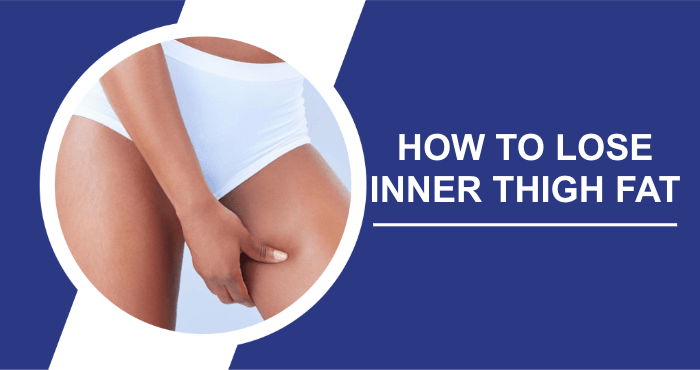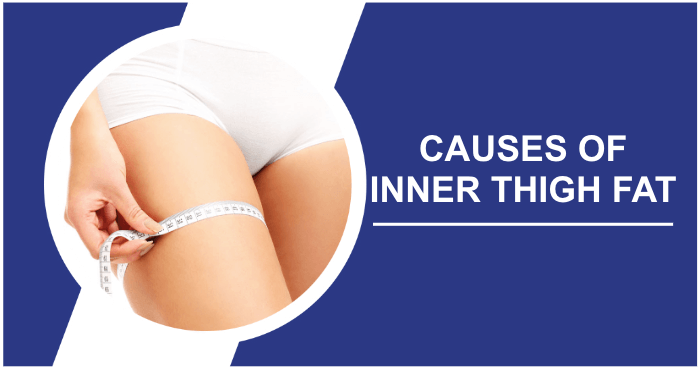Getting rid of fat from the thighs can be quite a tricky task. Women, who tend to accumulate fat in their thighs and hips, often struggle with achieving a more balanced body shape. It sometimes feels like all our food ends up in that area. So, how can we effectively tackle inner thigh fat? The answer lies in adopting a diet, making lifestyle adjustments and incorporating regular exercise into our daily routine. This article discusses how to achieve the slim and trim appearance we desire in our inner thighs.
Ways To Reduce Inner Thigh Fat
- Maintain a well-rounded diet.
- Consult with a healthcare professional for guidance.
- Ensure you consume several calories.
- Make exercise a regular part of your routine.
- Set realistic and achievable goals.
- Avoid relying on weighing yourself as a measure of progress.
How Fast Can You Lose Inner Thigh Fat?
Getting rid of fat in the inner thigh region can be pretty difficult since targeting specific areas for reduction is not a practical approach. However, if you concentrate on aspects like creating a calorie deficit, engaging in physical activity and including strength training in your regular routine, you may begin noticing noticeable transformations within a span of 4 to 6 weeks. It’s crucial to remember that outcomes can vary among individuals based on factors such as diet, the intensity of exercise and genetic predisposition.
Strategies To Reduce Inner Thigh Fat
Here are some steps you can take to help reduce fat in your thighs;
- Focus on eating a nutritious diet with superfoods for weight loss rather than just cutting calories. We’ll look at this in more detail later.
- It’s important to consult a healthcare professional before starting any diet or exercise programme, especially if you have a chronic health condition. Your doctor can confirm whether your diet and exercise plans suit you and help you achieve your goals.
- Ensure that you’re getting enough calories. While some individuals aim to stay below a threshold, ensuring you’re consuming enough is crucial. Avoiding calorie intake can actually impede your weight loss progress by decelerating your metabolism and triggering a state of starvation in your body. The key is to find a balance: enough calories to burn more than what you consume but sufficient so that your body doesn’t perceive food as scarce and activates its starvation response.
- Make sure you get some exercise every day. You don’t have to push yourself hard every time you train. It’s beneficial to mix high-intensity exercise with lower-intensity exercise. Keeping active is crucial to burning calories and reducing stored fat. Small changes like walking to the shops instead of driving or taking the stairs at work can help you progress towards your weight loss goals.
- It’s important to establish goals for yourself. By breaking down your goals into milestones, you can maintain motivation and stay on track. Celebrating the achievement of these milestones along the way will boost your motivation and keep you focused on your weight loss journey. Remember that reducing fat in areas like the inner thighs requires a holistic approach to weight loss. Keep these tips in mind as part of a strategy.
- Don’t rely solely on the number on the scale. Your weight will fluctuate due to water retention, which can temporarily add pounds and cause bloating in areas such as your face and stomach. Instead of just focusing on your weight, pay attention to how you feel overall, your height and how well your clothes fit.
With so many diets, exercise routines and supplements available, it’s not always easy when someone claims that all you need to lose thigh fat is a balanced diet and consistent exercise.
5 Essential Exercises For Toning Your Inner Thighs
When it comes to diet and exercise, no solution works for everyone. When deciding on the most suitable diet and exercise plan for yourself, it is crucial to take into account factors like your metabolic health, gender, level of physical activity, age, current weight, and body type.
Fat accumulation in the thigh area can be attributed to subcutaneous fat (located just under the skin) or intramuscular fat (inside the muscles). However, it’s impossible to target weight loss in one body area.
It is crucial to include targeted exercises in your routine to enhance the strength and tone of your thigh muscles. Begin by performing two to three sets of 8 to 10 repetitions for each exercise mentioned except for the seated bridge and seated hand push exercises. For the seated bridge exercise, start with three sets lasting twenty seconds each. For the hand push exercise, do one set lasting one minute.
Remember that consistency is vital to achieving the desired results. Listen to your body, and adapt these exercises to your fitness level.
- Rear Kick: Start by standing on one leg with your knee bent. Lift the leg immediately behind you, keeping a solid core and firm glutes. Lean forward and extend the lifted leg backward. Squeeze your glutes as you return to the starting position. Alternate. Repeat the movement.
- Gluteal Lifts: Start by standing on the floor with your knees bent and feet firmly planted to work on your glute muscles. Extend your arms out to the sides. Lift your hips until they form a 45° angle with your torso. Activate your glutes and thighs, maintaining this position briefly before gently lowering back down.
- Chair leg raises: For chair leg raises, sit in a chair with your feet flat on the floor and your hands gripping the sides. Bend your knees at 90 degrees. Raise your leg and hold for 30 seconds before lowering it back down. Repeat with the other leg.
- Chair Bridge: To perform a chair bridge exercise, start by sitting on a chair and ensure your feet are firmly planted on the floor with your knees bent at a 90-degree angle. To maintain balance, rely on the sides of the chair as you lift your hips off the seat and distribute weight onto your feet and hands. Hold this posture for 20 seconds, gradually lowering yourself back down. As you advance, feel free to increase the duration of this hold to one minute as your body adapts to the exercise.
- Chair Hand Press: Sit in a chair with your feet firmly planted on the floor. Bend your knees comfortably at a 90-degree angle. Place your hands on the sides of your knees. Apply pressure with your hands while pushing outward with your knees, and hold this position for one minute.
What Causes Inner Thigh Fat?
There are reasons why fat tends to accumulate in the thighs. Firstly it happens when you consume calories than you burn, which leads to overall weight gain that is often noticeable in the thigh region. Additionally genetics also influence how fat is distributed across the body. In women hormonal imbalances can contribute to the accumulation of fat, in the thighs.
A sedentary lifestyle and lack of targeted exercise can also increase fat in this area. Finally, as we age, our metabolism slows down, making it easier for fat to accumulate in the thighs.
Getting Rid Of Excess Inner Thigh Fat
Though it is important to have body fat for the proper functioning of our organs and overall well-being, it is not uncommon for some individuals to have an excess of unhealthy fat. Genetics often contribute to this, as women tend to store fat in their abdomen, hips, and inner thighs while men tend to store it around their stomach area.
Before embarking on any diet or exercise programme, it’s essential to consult a healthcare professional who can help you create a fitness plan tailored to your needs. To effectively reduce thigh fat, you must consume fewer calories than your body burns and incorporate regular exercise into your routine.
It’s worth mentioning that cutting down on calories doesn’t imply starving yourself. Excessive deprivation can impede your progress towards achieving your fitness objectives. The precise amount of calories you should consume varies based on age, activity level and current weight. Make it a priority to include foods as part of a well-rounded diet while integrating high-intensity interval training and resistance exercises into your exercise regimen.
One way to tone your thigh muscles is to work on them. It is essential not to neglect other muscle groups. This approach can help you lose weight more effectively across your body. What’s more, building muscle mass boosts your metabolism, which helps you maintain a toned appearance and ensures that you continue to burn calories even when you’re inactive.
Making changes to your lifestyle can help reduce fat in your thighs. One crucial step is to increase the amount of protein you consume while cutting back on processed foods, refined carbohydrates, and sugary drinks. Additionally, incorporating physical activity into your daily routine is crucial.
By following an exercise plan and eating a nutritious diet, you won’t have to rely solely on the scale to track your progress. Feeling more confident, having more energy, and noticing that your clothes fit better are all reliable signs that you’re successfully working towards your fitness goals.
Diet
To achieve this, it’s crucial to consume fewer calories than your body burns. Begin by utilizing a calorie calculator to determine the number of calories you require to maintain your weight. Next, decrease your calorie intake by 500 calories. This approach should assist you in losing one pound per week.
Remember, it’s not just about the quantity of food you eat, but also the quality. Choosing the right foods will help you lose weight and make you feel better overall. Here are some dietary changes that can help you achieve your weight loss goals;
- Choose larger than usual portions.
- Eliminate processed foods and refined carbohydrates from your diet.
- Cut out sweetened drinks such as soda and fruit juices.
- Increase your protein intake.
- Stay hydrated by drinking more water.
- Add physical activity to your routine.
In addition to taking care of your diet, incorporating exercises that specifically target the muscles in your thighs can significantly enhance your appearance. You can achieve this by engaging in activities like walking or jogging on a treadmill indoors or outside. Try including inclines during your walks or runs to make your routine more challenging. This will actively strengthen the muscles in your thighs. Incorporating this type of exercise into your routine two to three times is recommended.
Understanding Distribution In The Thigh Area
During times of famine and drought in the caveman era, the female body evolved to store fat in the thighs and hips as a survival mechanism. When pregnant and lactating, their bodies require an extra 1,000 calories a day on top of their basic calorie needs. They used the fat stored in their hips and thighs to support themselves and their offspring when food was scarce.
Women have historically benefited from the ability to store fat in areas that have been passed down through generations. Factors that predispose individuals to store fat in this specific area could explain the challenge of losing thigh fat.
While men generally store fat around their abdomen, they can also accumulate fat in their thighs. Research conducted by the Harvard T.H. Chan School of Public Health found that men with high levels of thigh and belly fat had a higher risk of developing advanced and potentially fatal prostate cancer.
Nowadays, it’s not common for people to face food scarcity. In fact, we often have abundant food, making losing weight more challenging. The best way to reduce thigh fat is by following a balanced diet and incorporating regular exercise into your routine.
Leg Muscles
When working out, it’s important not to focus on your leg muscles. Trying to target parts of the body for weight loss isn’t generally effective. Instead, focus on exercises that work for multiple muscle groups at once. Squats, lunges, pull-ups, and push-ups are examples of such exercises.
If you’re looking to optimize burning, particularly in the inner thigh region, incorporating 20 minutes of high-intensity interval training can prove highly advantageous. This specific workout has the potential to enhance not only your aerobic endurance but also fortify your muscles.
For a well-rounded fitness routine, aim for a mix of aerobic and anaerobic exercise. Aerobic exercise, such as jogging, cycling, or brisk walking, increases your heart rate and can be maintained for longer periods. Anaerobic exercises focus on short bursts of intense activity. Activities such as sprinting, interval training, and weightlifting fall into this category.
It’s worth mentioning that consistently restricting calories over a period can actually slow down your metabolism and result in muscle loss as your body tries to conserve energy. However, engaging in weightlifting exercises can help offset this impact by providing a challenge to your muscles. By building muscle, you’ll not only boost your metabolism but also reduce the risk of losing muscle mass.
Leg Fat And Cellulite
In addition to health concerns, carrying excess weight can have aesthetic impacts. One of these effects is fat accumulation in the legs, which can give the appearance of skin. Often, individuals tend to develop cellulite around their thighs and buttocks, particularly when they have extra pounds.
Although cellulite is not a health hazard, some people prefer to achieve good-looking skin. A balanced diet and regular exercise can help reduce the appearance of cellulite. Cellulite creams on the market also claim to reduce the appearance of cellulite. Among these options, creams infused with CBD oil are showing promising results. Early animal studies suggest that CBD may reduce food intake and improve metabolism.
What Are The Most Common Mistakes People Make?
Many people make errors when trying to lose thigh fat. One such mistake is believing in spot reduction, which unfortunately doesn’t work, as fat loss occurs evenly throughout the body. Another error is neglecting the significance of maintaining a calorie deficit through diet. Inconsistency in exercise also hampers results, so following a diverse workout routine is better.
Combining cardio with strength training is more effective for toning muscles than relying on it alone. It’s important not to focus on thigh fat but also on total body fat. Finally, it is important to be patient and understand that sustained fat loss is a process rather than expecting quick results.
Are There Any Risks To Losing Inner Thigh Fat?
Getting rid of thigh fat can be challenging, especially if it results in significant weight or muscle loss. Swift or extreme fat reduction in this area may cause issues, like skin or muscle loss, which can impact your ability to move and maintain balance. It’s crucial to prioritize weight loss while maintaining muscle strength through a comprehensive and balanced exercise regimen.
Remember that over-exertion in any body part can lead to imbalance and possible injury. As always, it’s a good idea to consult a healthcare professional to help you achieve a sustainable approach to weight loss.
Frequently Asked Questions
What exercises are effective for reducing fat in the thigh area?
To tone and target the muscles of the thighs, you can try exercises like leg lifts and presses for the inner thighs and lunges. Including these exercises in your workout routine can assist in slimming and toning this area. Furthermore, engaging in activities such as cycling, running or climbing stairs can aid in reducing overall body fat, including fat stored in the thighs.
Can targeted techniques effectively reduce fat in the inner thighs?
Spot reduction or targeting a specific body area for loss is primarily considered a myth. While exercises focusing on the thighs can help tone and strengthen those muscles, they won’t burn fat from that area alone. The practical approach combines overall weight loss through proper diet, exercise, and muscle toning.
How does diet impact the reduction of fat in the thigh region?
Maintaining a rounded and nutritious diet is essential to effectively lose fat. Prioritize consuming protein, whole grains, fruits, vegetables and healthy fats. By reducing your calorie intake while following an eating regimen, you can effectively promote fat loss throughout your entire body, including targeting the inner thighs.
Are there any stretches that can assist in slimming down the inner thighs?
While stretching alone won’t directly lead to weight loss in this particular area, it can improve flexibility and the appearance of muscle tone. Incorporating stretching exercises into your routine can help improve leg flexibility while giving your legs a more toned look. Stretching the thighs, such as butterfly stretches or side lunges, can really help lengthen and relax these muscles. This is great if you want to tone your thighs as part of your fitness routine.
So how long does it usually take to start seeing changes in the thigh area?
Well, it actually varies based on factors such as your eating habits, the intensity of your workouts and even your genetic composition regarding fat distribution in your body. Generally speaking, if you remain dedicated and follow a diet and exercise regimen, you might begin noticing changes within approximately 4 to 6 weeks. However, remember that everyone’s body is unique, so some individuals may require a bit of time to see noticeable progress.
The Bottom Line
Getting rid of inner thigh fat requires specific training, a balanced diet and consistent lifestyle changes. An approach that includes strength training, cardio exercise and a healthy diet of lean proteins, vegetables and whole grains can make a noticeable difference. In addition, staying hydrated and getting enough sleep are crucial factors in achieving this goal.
Sources
- ScienceDaily. (2013). How belly fat differs from thigh fat, and why it matters. [online] Link.
- National Institute of Diabetes and Digestive and Kidney Diseases. (2021). Factors Affecting Weight & Health | NIDDK. [online] Link.
- Centers for Disease Control and Prevention (CDC). (2021). Maternal Diet. [online] Link.
- Dickerman, B.A., Torfadottir, J.E., Valdimarsdottir, U.A., Giovannucci, E., Wilson, K.M., Aspelund, T., Tryggvadottir, L., Sigurdardottir, L.G., Harris, T.B., Launer, L.J., Gudnason, V., Markt, S.C., & Mucci, L.A. (2019). Body fat distribution on computed tomography imaging and prostate cancer risk and mortality in the AGES‐Reykjavik study. Cancer. [online] Link.
- Rosenbaum, M., & Leibel, R.L. (2010). Adaptive thermogenesis in humans. International Journal of Obesity, 34(S1), pp.S47–S55. [online] Link.
Mark Willson, holding a Ph.D., functions as a psychotherapist in Washington, D.C. His specialized fields encompass addiction, anxiety, depression, as well as sexuality and interpersonal connections. Dr. Willson holds the distinction of being a diplomat for the American Board of Addiction and Anxiety, further serving as a certified counselor and addiction specialist.
Aside from his personal professional endeavors, Dr. Wilson has engaged in roles as an author, journalist, and creator within substantial medical documentary projects.
Isabella Clark, Ph.D., held the position of a professor within Emory University’s School of Medicine, working in the Department of Mental Health and Nutrition Science. Alongside this role, she served as a research associate affiliated with the National Research Center. Dr. Clark’s primary area of research centers on comprehending the mechanisms through which adverse social encounters, encompassing prolonged stress and traumatic exposure, contribute to a spectrum of detrimental mental health consequences and coexisting physical ailments like obesity. Her specific focus lies in unraveling the reasons behind the varying elevated susceptibility to stress-linked disorders between different genders.






